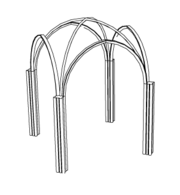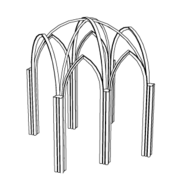Vault
|
|
Template:Alternateuses In architecture, a vault is an arched structure of masonry, forming a ceiling or canopy. Vaulting makes it possible to roof over a comparatively large space using bricks, stone blocks or concrete. Until the development of metal girders and trusses in the 19th century, the only alternative was to use long wooden rafters or long stone lintels — much simpler than vaulting; but cruder and more expensive as well, and ultimately limited by the length of wood or stone available. The Romans made an art form of the vault and it has remained popular ever since.
Types of vaulting through European history
- The most basic sort of vaulting is the Barrel vault (or tunnel vault). As its name suggests, it consists of a simple (usually semicircular) arch repeated longitudinally to form a tunnel. Although a barrel vault can successfully roof a wide hall, the difficulty is then lighting that hall — the vault cannot safely be pierced by more than the smallest of windows.
- A groin vault must be built where two barrel vaults intersect perpendicularly. Imagine two perpendicular barrel vaults built on the same square site; then mentally erase the redundant bits (i.e. the lower of the two vaults at each point). What will remain is as follows: an open square with no walls but merely a column in each of its four corners. A single arch connects each pair of neighboring arches, and another larger arch connects each pair of diagonally opposite corners. Each of four triangular quadrants formed by these two crossing arches is vaulted in what is roughly a barrel vault.
If a set of parallel barrel vaults intersects with another, perpendicular set of barrel vaults, a grid of groin vaults will result. Roman baths were often built in just such an elaborate series of such groin vaults.
- After the fall of the Roman empire, few buildings large enough to require much in the way of vaulting were built for several centuries. In the early Romanesque period, a return to stone barrell vaults was seen for the first great cathedrals; their interiors were fairly dark. But with the reintroduction of the groin vault, more light could be brought into the buildings: instead of building groin vaults as the intersection of two barrell vaults, the master masons simply built one long line of groin vaults. Now two sides of each vault lay on the axis; but the other two transverse sides were left unattatched. Instead, they could be filled with windows. Durham Cathedral in the north of England is an excellent example of a Late Romanesque cathedral built with groin vaults.
- Soon after this development, architectural taste in Europe swung in favor of the Gothic arch, which was pointed instead of rounded. Gothic cathedrals were built in the same manner, as a line of groin vaults; and as techniques improved, were more and more light-filled. The six principal arches of the vault (as described above) were generally more heavily built than the intervening spaces, and so the term rib vault is typically applied to these vaults. Looking upwards at a rib vault, one sees these six ribs serving as the 'skeleton' of the vault. (Technically speaking, this standard type of vault is called a quadripartite rib vault; with a slight variation, it became a Sexpartite rib vault which is divided by eight ribs into six parts.)
- Later Gothic architecture, particularly in England, saw even more elaborate vaults, such as Net vaults and Fan vaults. See Perpendicular Gothic.
Construction
The obvious way to construct a vault is by constructing scaffolding to hold up all the pieces. This is extremely expensive, however. Most classic vaults are self-supporting in construction, or built with jointures.
In a self-supporting vault, the starting arches have to be built with scaffolding, but after that, the bricks or stone blocks interlock, permitting additions until the vault is complete.
One of the easy ways to start an arch or construct a vault uses a "jointure", a beam or clamp with faces to grip the top blocks. Each time a block is added, the jointure is walked up to the next block on that side. The construction of jointures used to be a trade secret of masons. Some classic vaults are made to be constructed with jointures.
There are several inexpensive ways to construct concrete vaults. One of the simplest (invented by Paolo Soleri) is to form or dig a mold in the earth, pour the concrete, and then remove the earth. This is extremely effective with unskilled labor, and produces beautiful, durable buildings.
Another way (invented by Christopher Alexander) is to construct hollow pillars and an inner vault surface of flimsy, good-looking surfacing materials (pretty wood paneling or gypsum board). These also include the internal rebar, anchor studs, ducting, and piping. Then, these are filled with low density concrete, usually made with pumice or zeolite in place of silica gravel, and possibly with the addition of glass bottles (which are even lower density). The result is improvisable (the early stages are more like constructing a stage set than real construction), sturdy and attractive. Further, no wood, steel or other scarce materials are required for construction up to three stories tall.
Special cases
- corbel vaultingde:Gewölbe


